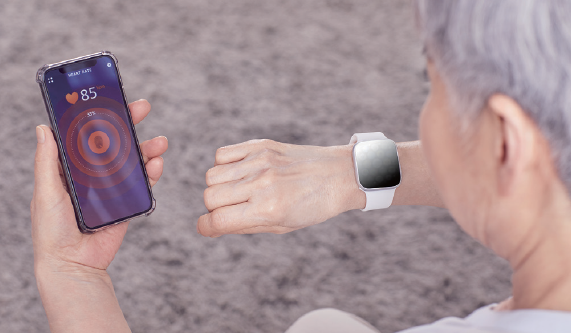This January, the Korea Health Industry Development Institute (KHIDI) stated the future growth of the digital healthcare industry through the International Medical Trends Report 2023. In the middle of the industry’s growth stands wearable medical devices. Also, as smart devices became more common, personalized healthcare with wearable medical devices is at the center of attention. Reflecting on such issues, the Sungkyun Times (SKT) would like to introduce the definition and problems of wearable medical devices and what directions to take.
What Are Wearable Medical Devices?
-Definition and Division of Wearable Medical Devices
Wearable medical devices are body-attached devices that measure and provide healthcare information. They come in the form of accessories, body-attached devices, and bioimplants. Smartwatches and smartbands are examples of accessories, which can be worn daily. Medical wearables can be classified into wellness and medical devices depending on their purpose. Wellness devices manage personal health information like blood pressure and activity rates, and include bio-signaling devices, fetal monitors, and nerve monitors. Meanwhile, pain control, hearing aids, and insulin pumps are classified as medical devices, which can supervise emergencies like shock and seizure. Today, medical wearables help people’s lives in various ways with their diverse functions.

-Usage of Wearable Medical Devices
The current wearable devices are utilized in various medical fields such as hospitals, patient monitoring, and pharmaceutical research. New wearable medical devices are being developed including asthma and insulin management, allowing hospitals to record patients’ health data through remote diagnosis and noninvasive monitoring. In pharmaceutical research, data from users of various age and demographic groups are collected to foster product development. With such usages, wearable devices in healthcare are gaining popularity among the medical paradigm of personalized health services. According to a 2021 research by Global Market Insights, the global market of medical wearables exceeds $25 billion, and the average annual growth is expected to increase by 22.9% by 2027. This further proves how these smart devices stand at the heart of the medical industry alongside the rapid technological growth.
The Challenges of Medical Wearable Devices
-Information Leakage and Insufficient Legal Restrictions
Wearable medical devices collect and accumulate a considerable amount of individual’s medical information to provide healthcare services. However, the consequences are immense when medical data is leaked, as medical records are treated as sensitive information, especially for insurance purposes or job applications. Unfortunately, there has already been massive data leakage from wearable medical devices because of their vulnerable security systems. In 2018, St. Jude Medical recollected their implant cardiac pacemakers due to hacking issues. Cyber security threats were also found in private medical data from Medtronic’s insulin pumps. In addition, the problem occurs as legal regulations are not imposed on information breachers. This is because they often conduct de-identification of users’ information in order to avoid legal punishment. The pseudonymous data they process can even be used commercially for the marketing purposes of insurance companies without the subjects’ agreement. The revision of the Personal Information Protection Act in 2020 – which was born from the increased cases of abusing private information – has allowed such usage of personal data if it is processed to be pseudonymous. When the user data of wearable medical devices is leaked, it makes a legal blind spot that continues to fail from preventing information leakage.
-Possibility of Inaccurate Diagnosis
Through wearable medical devices, users can identify and diagnose their health conditions without physically visiting the doctor. However, the possibility of diagnosis error also exists. Such misdiagnosis can happen because of the software itself or the user’s adaptation of the device. In 2022, the annual conference of the American College of Cardiology (ACC) announced that smartwatches measure heart rate and electrocardiogram differently depending on the user’s skin tone. It showed that the darker the skin is, the lower the accuracy in bio-signaling even up to 40%. Apart from that, a consumer electronics and fitness company Fitbit’s heart monitor has also miscalculated the heart rate of a user – that was exercising strenuously – as 20 beats per minute. Besides software problems, inexperienced users can also cause misconduct as they are not adept at using the devices. According to the 2021 announcement of the Korean Society of Hypertension (KSH), errors commonly happen when users measure their blood pressure using a smartwatch. The KSH pointed out that this happens because imprecise calculation arises from not having a stable posture during self-diagnosis. Subsequently, this misdiagnosis of devices induces wrong treatment and raises the anxiety of users.
-Harmful Effect on Human Body

Ensuring safety is the most important factor of wearable medical devices as they are constantly attached to the user’s body. Nonetheless, there are many complaints regarding injuries from heat generation and explosions of batteries. In 2022, Fitbit decided to withdraw a smartwatch, Ionic, that was sold for three years from 2017, because of its skin burn incidents. The Consumer Product Safety Commission (CPSC) reported 174 cases regarding the heating of Ionic batteries, which caused second to thirddegree burns on its users. That same year, a user revealed in their social media that their Apple Watch Series 7 exploded from overheating. Moreover, devices can also cause skin problems as they are worn in close contact to human skin. According to an 2022 Allure article, a New York City dermatologist Angela Lamb said that wearable medical devices are likely to cause skin inflammation since they include allergenic metals such as nickel and alloy. Also, many analyses revealed that wearable devices can harm users which contradicts their purpose of supporting healthcare.
The Direction Wearable Medical Devices Should Pursue
-Measures to Prevent Information Leakage
In order to ensure the privacy of the users, the developers must take adequate responsibility for their devices. They should establish guidelines that can enforce corporations to prevent the leakage of information collected from devices, such as user’s location and photos. In 2020, the International Conference on Innovative Computing and Communication (ICICC) presented seven guidelines to solve the security vulnerability of wearable medical devices. The guidelines includes the following: Respect for Context, as in the user’s agreement on the gathered data from the devices, Transparency, and De-identification. If the developers establish their standards by referring to the mentioned guidelines, the invasion of privacy and information leakage could be prevented further. Not only the developers but the government too, should also establish policies to strongly punish those who have leaked personal information. In that regard, they should revise the current Personal Information Protection Act which does not prevent the commercial utilization of pseudonymous data. The European Union (EU) enforces the General Data Protection Regulation (GDPR) that defines pseudonymous data as personal information which need to be strictly protected. Following such an example, a considerable solution would be expanding the range of personal information. Therefore, by amending the Protection Act, those who leak information from wearable medical devices could be strongly punished.
-Improving Accuracy to Recover Reliability
Research to improve the accuracy of these devices is necessary to stop the errors of the software. Reflecting large samples of data on people’s physical traits, such as their skin tone, is vital for product development. In addition, the government should establish guidelines to retrieve the reliability of wearable medical devices. For instance, the United States Food and Drug Administration (FDA) announced the guidelines for licensing wearable medical devices to reduce potential harm. Likewise, the government must take responsibility to regulate the products that do not meet international standards of safety. Meanwhile, to prevent errors from users who are not familiar with the devices, education regarding the use of wearable medical devices must be reinforced. In the case of wearable insulin pumps for diabetic patients, the government conducted a homebased education project that educates about the method of device use in 2020 to overcome the limits that come from its complicated use. By expanding this home-based education, the users can be well aware of the correct use of complicated devices. Research on the accuracy of the devices and the government’s effort to supervise developers would further brighten the future of wearable medical devices.

-Need to Ensure Safety for Users
Since overheating and explosion usually stems from the technological deficiency of the devices’ batteries, developers should study and utilize new substances to solve such problems. In 2021, researchers of the Gwangju Institute of Science and Technology (GIST) developed an adiabatic electronic device that cooled down without a power supply. Meanwhile, smartwatch developers, who suffer the most in dealing with technological problems, would find it better to use new materials in their products. In addition, the corporation has the responsibility of recalling a product and acknowledging the cause clearly when technical errors occur. For instance, when the overheating was detected in their Ionic model, Fitbit openly admitted their fault, recalled their model, and further compensated the victims. Lastly, to avoid skin diseases, the use of new materials is needed. Several smartwatch developers that use nickel and alloy for their products such as Apple, Fitbit, and Samsung should especially put effort into solving the issue of skin inflammation. As nanomaterial electronic skin does not cause skin inflammation due to its penetrability of oxygen and sweat, developers could use them as an alternative to prevent skin problems.
As interest in private healthcare grows, people’s lives and wearable medical devices will become heavily linked. However, if problems with safety, data leakage, and diagnostic inaccuracy continue, wearable medical devices will not be able to withstand their upward trend in popularity. If the technology further develops to surpass such limitations, the wearable medical device industry could show further remarkable growth in the future.
